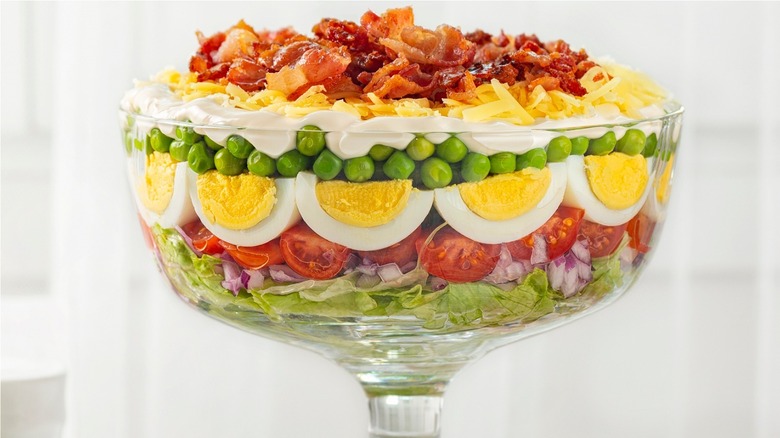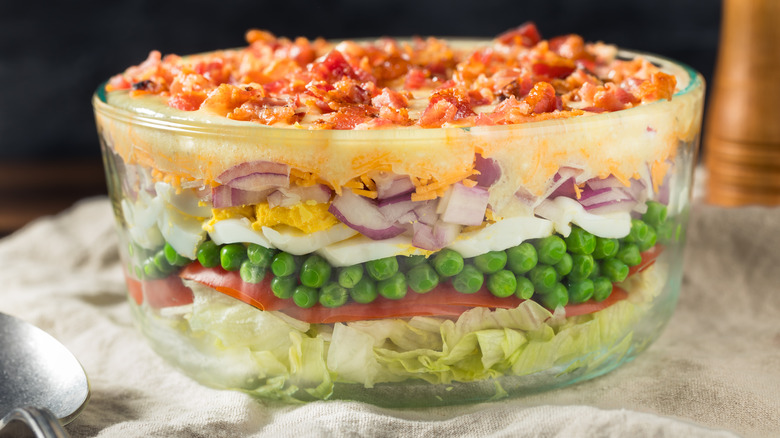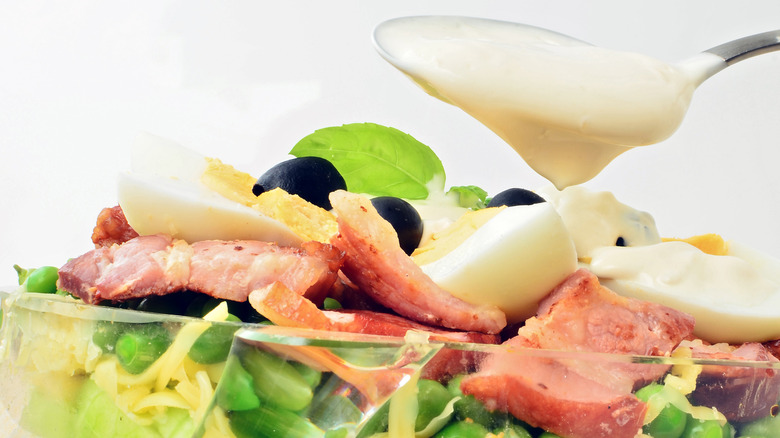The 7-Layer Salad Is A Mid-Century Delight That Calls For Lots Of Peas
The seven-layer salad stands as an enduring American culinary icon, cherished for its colorful presentation and role as a quintessential dish in communal gatherings. Rooted in mid-20th century potluck culture, it embodies the essence of comfort food, offering nostalgia in every forkful.
The multitiered salad serves as a feast for the eyes as well as the taste buds. This vibrant salad is a work of art that contains a medley of colors, flavors, and textures. The foundation, a bed of crisp iceberg lettuce, provides a satisfying crunch. But the true magic unfolds as the layers continue: juicy cherry tomatoes and diced red onions punctuate the dish with a burst of zest and pungency. Soft, sweet green peas add a luxurious creaminess, harmonizing with the tangy notes of velvety mayonnaise and grated cheddar cheese. Sliced, hard-boiled eggs bring a hearty profile to the ensemble. Atop it all, crumbles of crispy bacon lay nestled, adding a salty, savory, aromatic dimension.
The salad is traditionally served in a transparent bowl to showcase the individual veggies like stripes on a painting — that is, before it gets all mixed up on your plate. Whether it's a family picnic, a potluck, or a charming luncheon, the seven-layer salad has been captivating hearts and palates alike for generations.
The 7-layer salad dates back to the 1950s
It is widely believed that the seven-layer salad was first assembled in the American South in the 1950s. The simple, hearty, beautifully assorted salad's popularity soared as it aligned with a cultural shift towards convenience and creativity in the kitchen. Before long, the clear glass bowl arrangement became synonymous with potlucks, barbecues, and family reunions. The salad's meticulous yet simple assembly process encouraged cooks to infuse their personalities, resulting in a diversity of interpretations while retaining a shared foundation.
The seven-layer salad appeared in community cookbooks, magazines, and even on television shows. Its endless adaptability further contributed to its success, with variations incorporating produce and proteins such as black-eyed peas, bell peppers, chickpeas, grilled chicken, black olives, and even avocados. While its exact origin remains uncertain, the seven-layer salad encapsulates an era when practicality and communal sharing were becoming even more highly valued. Its enduring presence on tables across America underscores its place as a classic meal that continues to provide an appetizing glimpse into the past.
The 7-layer salad calls for plenty of delicious ingredients, including peas
The seven-layer salad is the epitome of abundance and variety. As the straightforward name suggests, this dish is typically constructed in seven distinct layers, which are carefully arranged to initiate an enticing presentation. One such layer may cause folks to scratch their heads, as it isn't an all-too-common salad element: peas.
Peas are a key ingredient in the seven-layer salad for several compelling reasons. First and foremost, their vibrant green color creates a striking contrast with the other ingredients. This aesthetic quality enhances the salad's overall presentation. Beyond their visual appeal, peas contribute a burst of freshness and sweetness and provide a refreshing balance to the creaminess of the eggs, cheese, and mayo dressing and the hardiness of the onions, lettuce, and tomatoes. This balance ensures each bite is a harmonious blend of tastes and mouthfeel.
The beauty of the seven-layer salad lies in its versatility; while the core ingredients remain consistent, there are plenty of ways to lend a personalized twist to the time-honored recipe. With its dynamic combination of textures, flavors, and colors, the seven-layer salad continues to grace tables to this day. While rooted in tradition, this salad has evolved with modern ingredients, reinforcing its status as a culinary star that bridges generations.


